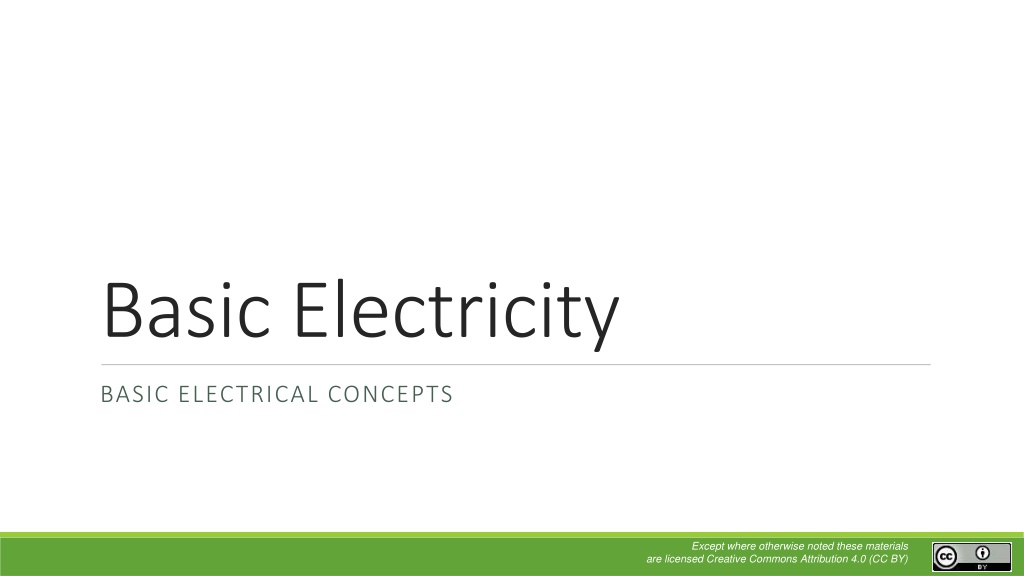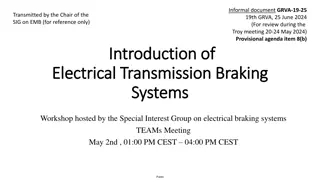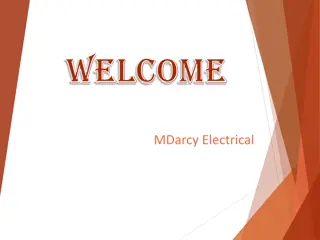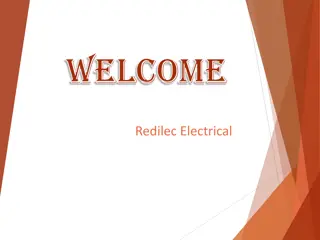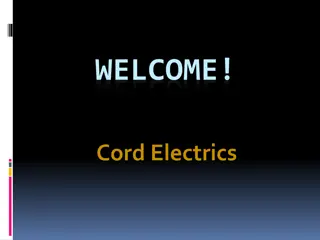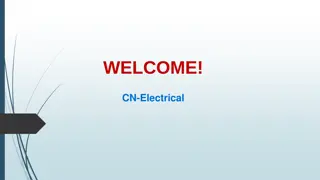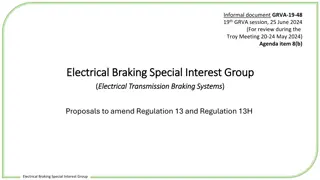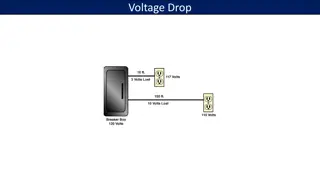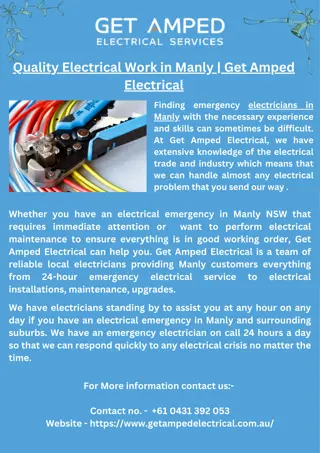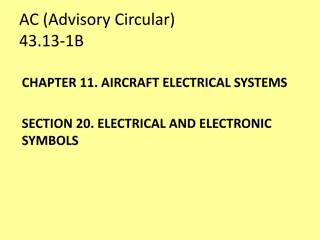Understanding Basic Electrical Concepts
Delve into the fundamentals of electricity, covering atom structure, electrical materials, direct and alternating currents, and more. Gain insights into key terms and definitions essential for basic circuit analysis. Explore the significance of atom charges, materials conductivity, and the role of photons in electrical energy.
Download Presentation

Please find below an Image/Link to download the presentation.
The content on the website is provided AS IS for your information and personal use only. It may not be sold, licensed, or shared on other websites without obtaining consent from the author. Download presentation by click this link. If you encounter any issues during the download, it is possible that the publisher has removed the file from their server.
E N D
Presentation Transcript
Basic Electricity BASIC ELECTRICAL CONCEPTS Except where otherwise noted these materials are licensed Creative Commons Attribution 4.0 (CC BY)
The objective of this unit is to present the student with some basic terms relating to electricity. Upon completion, the student will have an understanding of the following: Basic atom structure Key terms and definitions Basic circuit analysis and recognition of differences Basic notations and conversions For any calculations made, it is critical to carry proper units. An answer is incorrect if it is not identified properly. Objectives Basic Electricity
Atom Structure Made up of electrons, protons, and neutrons The nucleus contains the protons and neutrons. The shell contains the electrons, which orbit the nucleus. The building blocks of matter The atomic structure of a material will help to determine the ease of current flow Atoms can be charged. Positive Negative Neutral The importance of the atom Law of Charges: Like charges repel each other, and unlike charges attract each other. A material that has an excess of electrons will take on a negative charge. A material that has fewer electrons than protons will have a net positive charge. Basic Electricity
Electrical materials used Insulators: Materials that inhibit the flow of free electrons; this material has only a few free electrons Conductor: Materials that readily allow for the flow of free electrons and have many free electrons Semi-conductors: A material that has more free electrons than an insulator but fewer free electrons than a conductor Electrical Materials & Photons Photons The basic unit of light energy Light can be considered to consist of a stream of tiny particles of energy called photons. This is used in Solar Photovoltaics and helps with the creation of electricity. P-N Junction could be considered the heart of the solar cell. Basic Electricity
Direct Current-DC Current flows in one direction only. Car Battery Photovoltaic cells Alternating Current-AC Current flows in one direction, then the other, and alternates back and forth. This is what is used in one s home single phase. Can be transformed Electricity for Renewables Basic Electricity
DC + + 0 0 - - DC Examples of DC & AC Currents AC AC + + 0 0 - - Northeast Iowa Community College [CC BY 4.0] Basic Electricity
Current: The flow of electrons through a conductor Measure in Ampere Measured with Amp Meter Electron Current flow Negative to positive flow Conventional Current flow Positive to negative flow Flow of Electrons through Conductor Electron Current + - + - Conventional Current Northeast Iowa Community College [CC BY 4.0] Basic Electricity
Voltage: Pressure or force that pushes current through a conductor Measured in volts Can be measured with or without current flow Measured with volt meter Potential difference between two points A battery or PV source provides a DC power source A rotating generator could produce AC Some power supplies that convert AC to DC or DC to AC Understanding Voltage R1 Sun I Voltmeter 28 VDC I R2 Northeast Iowa Community College [CC BY 4.0] Basic Electricity
Resistance: Opposition to current flow Measured in ohms Measured with ohmmeter Power: The rate of work or energy consumption Measured in watts Measures the rate at which energy is used in a circuit Electricity for Renewables Basic Electricity
A switch to control load for safety Power supply: Photovoltaic source to produce potential A path for electrons to flow - Wires in the circuit R1 Sun I Understanding the Circuit Voltmeter 28 VDC I R2 Northeast Iowa Community College [CC BY 4.0] Basic Electricity
Ohms Law It requires one volt to push one amp of current through one ohm of resistance in a DC circuit. It is a proportion that shows how voltage (V), current (I) and resistance (R) are related in a circuit. ? = ? ? R ? =? ? Ohm s Law ? =? ? Examples: ? = 12?,? = 3? ?? then 12? 3? ??= 4 ???? ? = ? Basic Electricity
The chart is divided into four sections with formulas that can be utilized. Power (P) Resistance (R) Voltage (V) Current (I) Example: If the power is 180 watts and the voltage is 40 volts, then the formula we need to calculate current is: Identifying the Equation ? =? ?=180 40= 4.5 ???? P R E2 R P E E I E R I2R E I P I R E P R P I2 I R P I E2 P Basic Electricity Northeast Iowa Community College [CC BY 4.0]
Energy Use: Utility companies sell energy consumption. Any power one can generate on one s own is money saved. ?????? = ????? ? ???? To determine energy consumed, multiply watts times hours of operation. ?????? Consumed = ????? ? ????? = ???? ????? (? ) A lighting fixture is drawing .71 amps with 120 volts applied. If the light is lit for 4 hours, how much energy is used? ? = ? ? ? = .71 ???? ? 120 ????? = 85.2 ????? ?????? = ? ? ????? = 85.2 ????? ? 4 ???? = 340.8 ? Equations for Energy Use Basic Electricity
Necessary Conversions one needs to know in electrical production kilowatt-hours (kWh) and megawatt-hours (MWh): 1kWh = 1000 watts for 1 hour 1MWh = 1,000,000 watts used for 1 hour To convert watts to kilowatts, divide by 1000. Example: If a circuit uses 11,500Wh of energy, a power company will charge the following: 11,500?? 1000 = 11.5?? Conversions Basic Electricity
Prefix Symbol Value Tera T One trillion (1,000,000,000,000) Giga G One billion (1,000,000,000) Engineering notation with metric prefixes Mega M One million (1,000,000) Kilo k One thousand (1,000) Milli m One thousandth (0.001) Micro One millionth (0.000001) Nano n One billionth (0.000000001) Pico P One trillionth (0.000000000001) Basic Electricity
1000? = 1 ?? =1000 1000 1,500,000 ? = 1.5 ?? = (1,500,000 1,000,000)* 0.0032? = 3.2 ?? = (0.0032 1000) 0.00004? = 40 ????????? = (0.00004 ? 1,000,000)* Examples of Conversions Basic Electricity
One path for current to flow Total resistance is equal to the sum of the individual resistances. Total voltage is equal to the sum of the individual voltage drops. Current is the same throughout the circuit. Laws that govern Series Circuits: ?? = ?1 + ?2 + ?3 + ?? = ?1 + ?2 + ?3 + ?? = ?1 + ?2 + ?3 + Series Circuit Copper Wire I- - Battery Load + I- Northeast Iowa Community College [CC BY 4.0] Basic Electricity
Voltage is the same throughout the circuit. Current is the sum of the individual circuits. Total resistance is always less than the smallest resistance. Laws that govern parallel circuits: 1 ?? = ?1+1 1 ?2+?3+ Parallel Circuits ?? = ?1 = ?2 = ?3 = ?? = ?1 + ?2 + ?3 + If there is the same resistance in parallel, the resistance can be divided by the amount of times used. Examples: ?1 & ?2 & ?3 = 10 ? ?? ?? =10 3= 3.3 ? ?? T + E R1 1 2 R2 3 - T Northeast Iowa Community College [CC BY 4.0] Basic Electricity
If there is different resistance in parallel, it can be grouped, using the following: ?1 = 50 ? ?? & ?2 = 75 ? ?? ? ?? ?? = 50 x75 50+ 75 = 30 ohms Parallel Circuits (continued) R1 50 R2 75 2 I1 I2 Northeast Iowa Community College [CC BY 4.0] Basic Electricity
Combines both series and parallel configurations Steps involved in solving circuits: First, determine the different series and parallel parts. Break down the parallel circuits to a single resistance. Redraw the circuit as a series circuit (critical step). Calculate total resistance. Calculate current if voltage is known. Calculate voltage if current is known. Series-Parallel Circuits R1 1k + - 3.2k E 48V R2 2.2k R3 I3 I2 IT R4 560k Northeast Iowa Community College [CC BY 4.0] Basic Electricity
Upon completion of this unit, students should be able to Protons and neutrons do not move from atom to atom. Current is the movement of electrons from one atom to another. Insulators inhibit the flow of electrons while conductors allow for free flow of electrons. Semi- conductors are somewhere in the middle and will become critical in PV cell design. Photons are energy particles from the sun used in the production of electricity in a PV module. Voltage, current, and resistance are all related and used in circuit calculations by incorporating ohms law. Energy consumed will be expressed in watt-hours, which is a calculation to use in determining a PV system and its requirements. Conclusions An electrical circuit has four requirements, including switch, load, power supply and conductors. Any circuit contains only two different items: a switch to pass power or a load to consume power. Circuits can be series, parallel, or series-parallel. Formulas exist to determine amounts. When working with formulas, the answer is wrong if units are not identified. This presentation was prepared by Northeast Iowa Community College under award EG-17-004 from the Iowa Energy Center. Any opinions, findings, and conclusions or recommendations expressed in this material are those of the author(s) and do not necessarily reflect the views of the Iowa Energy Center. Basic Electricity
